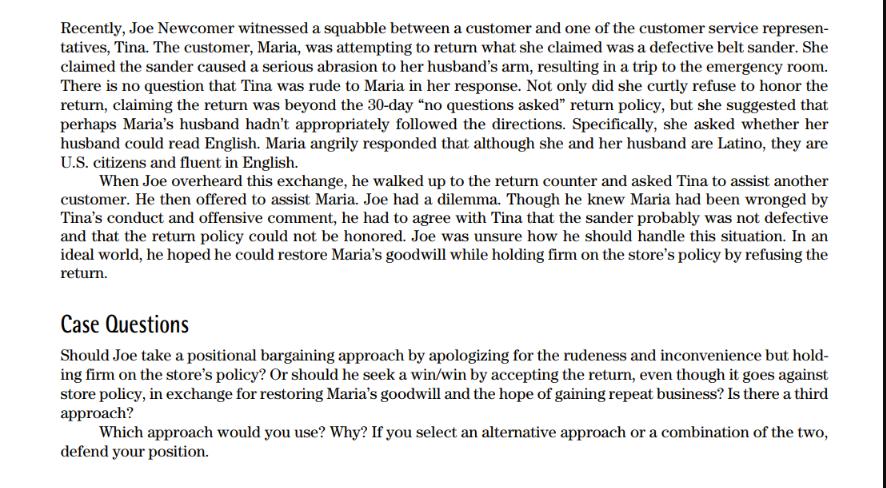Answered step by step
Verified Expert Solution
Question
1 Approved Answer
Recently, Joe Newcomer witnessed a squabble between a customer and one of the customer service represen- tatives, Tina. The customer, Maria, was attempting to


Recently, Joe Newcomer witnessed a squabble between a customer and one of the customer service represen- tatives, Tina. The customer, Maria, was attempting to return what she claimed was a defective belt sander. She claimed the sander caused a serious abrasion to her husband's arm, resulting in a trip to the emergency room. There is no question that Tina was rude to Maria in her response. Not only did she curtly refuse to honor the return, claiming the return was beyond the 30-day "no questions asked" return policy, but she suggested that perhaps Maria's husband hadn't appropriately followed the directions. Specifically, she asked whether her husband could read English. Maria angrily responded that although she and her husband are Latino, they are U.S. citizens and fluent in English. When Joe overheard this exchange, he walked up to the return counter and asked Tina to assist another customer. He then offered to assist Maria. Joe had a dilemma. Though he knew Maria had been wronged by Tina's conduct and offensive comment, he had to agree with Tina that the sander probably was not defective and that the return policy could not be honored. Joe was unsure how he should handle this situation. In an ideal world, he hoped he could restore Maria's goodwill while holding firm on the store's policy by refusing the return. Case Questions Should Joe take a positional bargaining approach by apologizing for the rudeness and inconvenience but hold- ing firm on the store's policy? Or should he seek a win/win by accepting the return, even though it goes against store policy, in exchange for restoring Maria's goodwill and the hope of gaining repeat business? Is there a third approach? Which approach would you use? Why? If you select an alternative approach or a combination of the two, defend your position. Think about the conflicts you have had with others in the past year. For the most part, did you take a positional or an interest-based approach to addressing them? Was your tendency to avoid, accommodate, compete, com- promise, or collaborate? Were you satisfied with the outcomes of these conflicts? If you were not satisfied with the way these conflicts were resolved, think about how they might have turned out differently had you taken a more interest-based, collaborative approach to resolving them. Write down the specific behaviors and skills you think you need to develop to be a better conflict man- ager. Further, write down your vision of a successful resolution to a conflict in general. Carry forward these thoughts and ideas as you read the remainder of the text and engage in the activities and discussions.
Step by Step Solution
There are 3 Steps involved in it
Step: 1

Get Instant Access to Expert-Tailored Solutions
See step-by-step solutions with expert insights and AI powered tools for academic success
Step: 2

Step: 3

Ace Your Homework with AI
Get the answers you need in no time with our AI-driven, step-by-step assistance
Get Started


